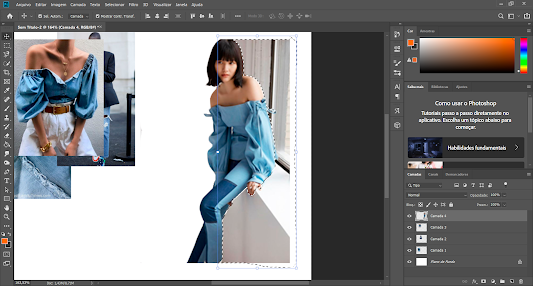Research - Embroidering Techniques
EMBROIDERING
In this research I want to explore embroidering techniques since my final 3D piece will be a scarf/shawl embroidered with my pattern.
I already have started this process and for that I have printed my pattern into a A3 blank page and then, using tracing paper, I drew the pattern again to be able to transfer it to the fabric itself. Initially, this went wrong and until today I am not able to understand why because when I start trying transfer the patter to the fabric the charcoal was not sticking to the fabric.
I suspect this was due to the type of pencil i was using or even because of the type of fabric but decided to find another solution. For that, I used light behind the pattern and the fabric and drew it directly onto the fabric. I knew that the initial steps of embroidery were like this because i have seen and embroidered with my grandmother who is used to this process as she spent her life doing it.
I felt I needed to know more about the vocabulary of embroidery and also some techniques that I don't know since I only know the most basic and simple ones and for that, I found a complete source that informed me.
The stitches are divided into four categories, each with its own set of effects and applications for embroidery:
Outline – This is a tool for sketching out the elements of your design.
Border – Adds textural dimension to your design while also securing the edges.
Detached – Used to fill in open areas of the design or to provide decorative features.
Filling – This is a technique for creating shading or solidly filling in a design field.
We also distinguish between three main styles of decorative needlework on a ground of some sort using needle and thread in the needlework world, each with their own general classification. The following are examples:
1. Surface embroidery
2. Counted work
3. Needlepoint or canvas work
Techniques:
Outlining, straight and curved lines are some of the things you can do about it. Working from the right to the left is the best way to go.
- Proceed by bringing the thread up at 1 and down at 2, up at 3 and down at 4, and so on.
- For a different look, the gaps between the stitches may be the same length as the stitches or shorter.
Keep an even tension on the thread and stop pulling it, or the stitches will pucker.
Back Stitch
Outlining, straight and curved lines are some of the things we can do about it. Working from the right to the left is the best way to go.
- Raise the needle to 1 and lower it to 2.
- Switch to the left and raise the needle to 3, then lower it to 1. Continue to stitch.
- Begin at the left and work your way to the right.
- Start at 1 and work your way down to 2.
- Return the needle to 3 and break the previous stitch's middle.
- Drop the needle to 4 and then back up to 2.
- Stitching should be continued.
For curvy lines, use shorter stitches.
Reference list:
CORBET, M. (2016) Needlework Terminology: Surface Embroidery. [Online] NeedlenThread.com. Available from : https://www.needlenthread.com/2016/10/needlework-terminology-surface-embroidery.html [Accessed 18/05/21].





You should include some of these terms in your glossary. Good reflection here in terms of how you problem solved the issues you had with transferring your design to your fabric. Which of the stitches are you using in your embroidery? I think you need to make that a bit clearer here.
ReplyDelete